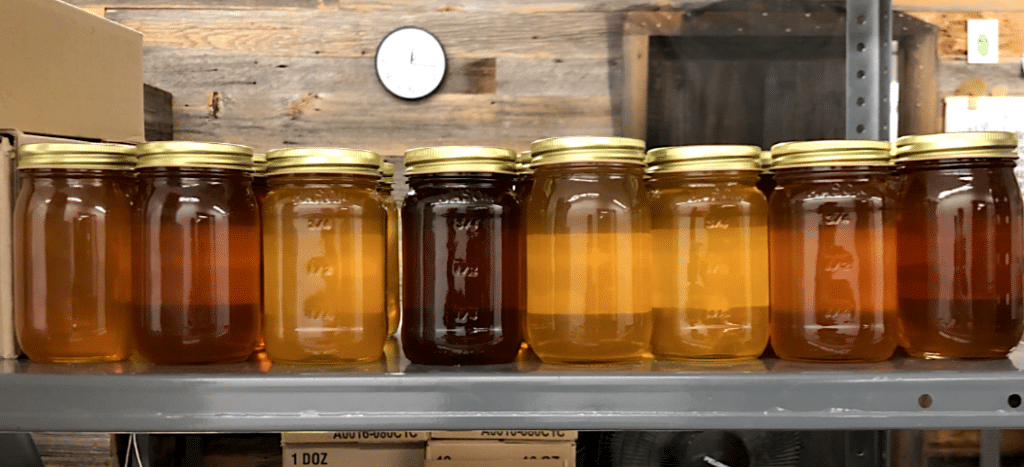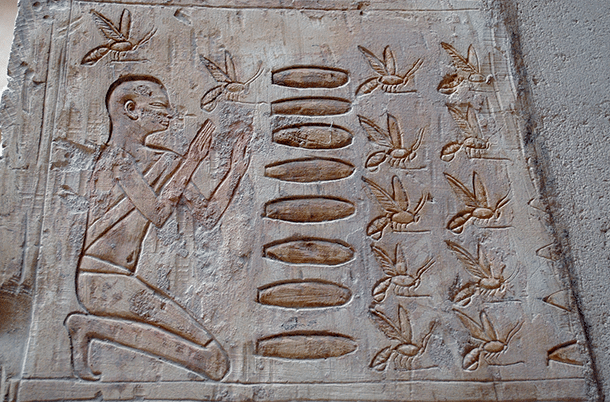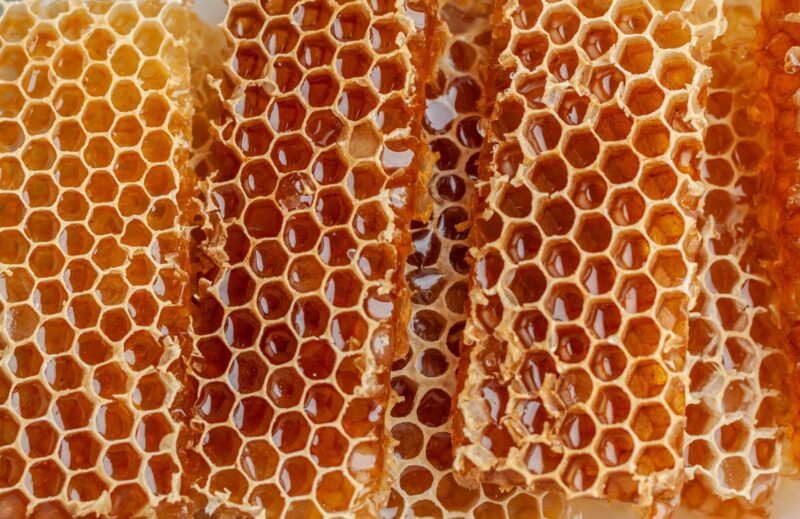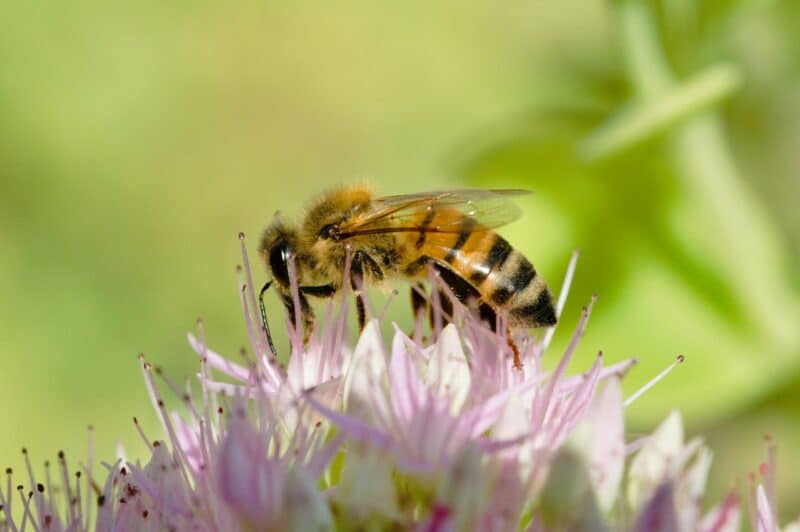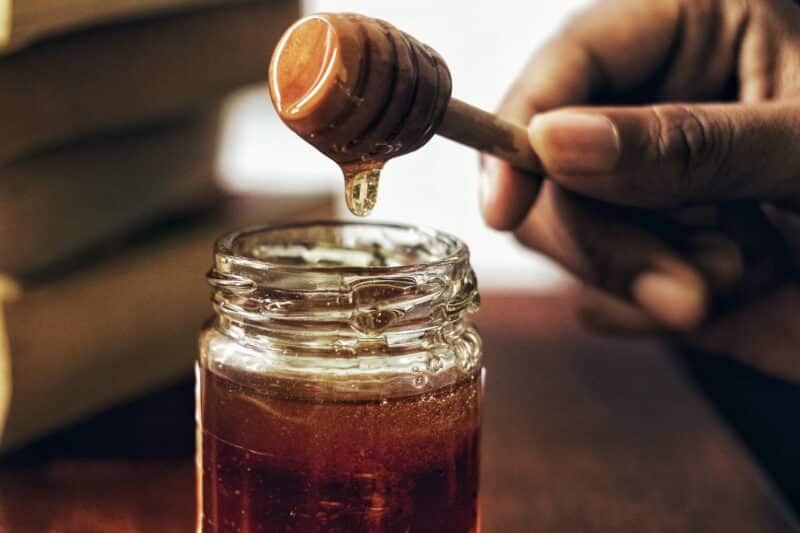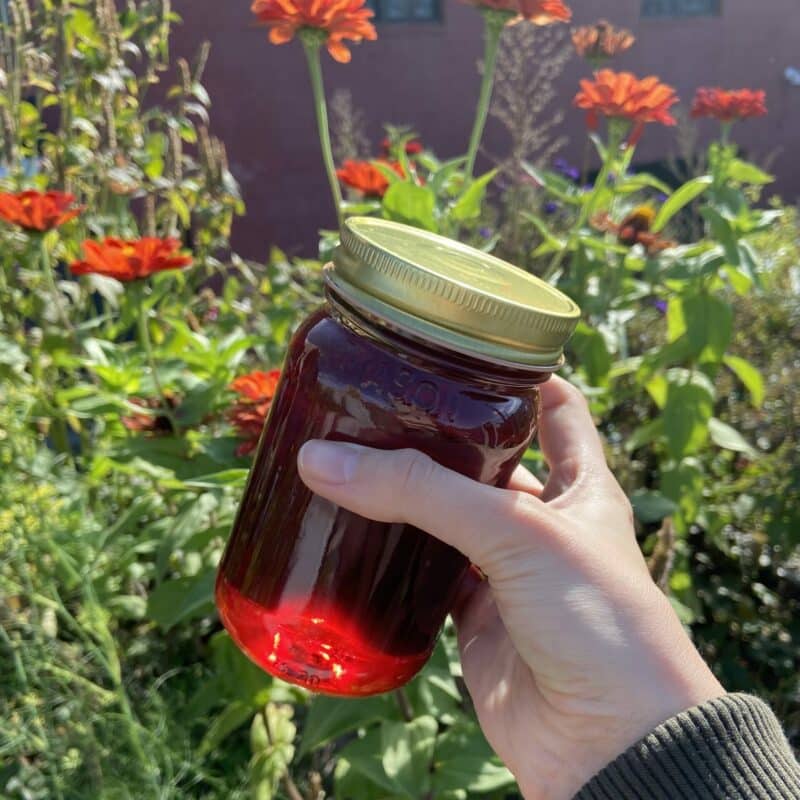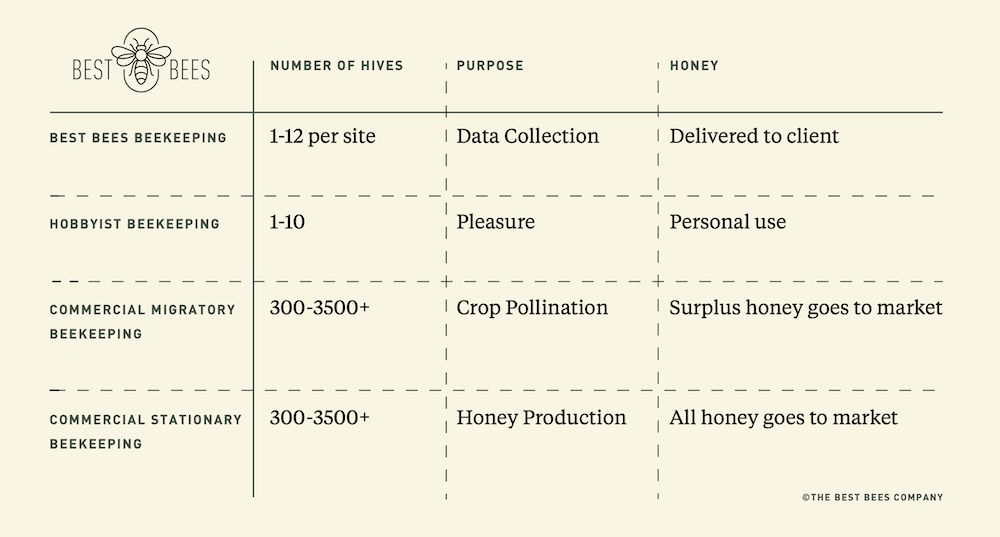Contents:
- The History of Honey in Food
- Types of Honey: Organic vs. Raw
- How Pollination Impacts Raw Honey’s Flavors and Color
- A Sensory Experience: Taste, Color, Texture
- Varieties of Raw Honey
- Infused Honey vs. Raw Honey
- Popular Infused Honey Flavors and Recipes
- Ways to Serve Honey
- FAQs
The History of Honey in Food
When the weather gets chilly, a cup of tea with honey is the perfect solution – but did you know that humans have been enjoying honey for thousands of years, when they first discovered wild honey bee hives? According to BugsInOurBackyard.org, the first record of organized beekeeping (also known as apiculture) dates back to ancient Egypt, circa 3,500 BCE. During this time, records show that people created extremely intricate methods for producing and gathering honey, “including specialized rafts for moving beehives along the River Nile to maintain close proximity to seasonal, flowering plants.” While citizens used honey as a natural sweetener, this liquid gold was also used for its antibacterial and anti-inflammatory properties, and was even used to treat wounds.
–– We pioneered the process of identifying the exact percentage of various pollen species found in honey through advanced genomic sequencing. Learn more on our Research page ––
The history of honey continued even after the ancient Egyptians, with records of German peasants paying their feudal lords in honey and beeswax in the 11th century A.D. – making it the first and most widespread sweetener used by man. Today, honey continues to be a natural sweetener that is enjoyed all over the world and in many different forms. At the Best Bees Company, we view honey as so much more than just a sweetener. It’s a product of all of the hard work done by honey bees, and without these pollinators, we wouldn’t have access to 70% of the food we eat!
We talked with Best Bees Head Harvester, Che Ashley, and Beekeeper, Mariah McDonald, about their love of honey, their favorite infused honey recipes, how pollination affects the appearance of honey, and their advice for those who want to dive deeper into the art of honey tasting.
Organic vs. Raw Honey
What makes honey “raw”, anyways? When you visit your local market or grocery store, you’ll often find many variations of honey—and as beekeepers, we always look for raw honey options. When honey is labeled as “raw”, this means that the honey inside that jar came directly from the honeycomb found in the beehive, without any processing such as fine filtering or heating.
Unlike processed honey, raw honey is not pasteurized (lowly heated), often has an opaque appearance, and can vary in color and texture in the most fascinating and delicious ways. Raw honey preserves its flavors by maintaining the integrity of pollen, microbes like food yeasts, and a variety of different sugars such as fructose. According to Mariah McDonald, an Herbalist and Beekeeper, honey becomes pasteurized once the glucose is cooked out of it, which also means that honey will not crystallize. Mariah recommends prioritizing local and raw honey in order to ensure that your honey has the antimicrobial, antiviral, and antifungal properties, because once the honey is heated – it simply turns into a sweetener.
Organic honey is a different story, and one that Mariah sees as a wonderful concept, but also very difficult to confirm. “I think [organic honey] is kind of a farce because bees fly at five miles in any direction. So unless you’re really in the middle of a huge organic land, there’s no way of guaranteeing that those bees didn’t fly to something that’s been sprayed with an inorganic compound.”
How Pollination Impacts Raw Honey’s Flavors and Color
One out of every three bites of food we eat is reliant on honey bees and native bee pollination, and the work that bees do has a great impact on the flavors and colors of raw honey that you might have in your home. The varying colors and viscosities of honey are directly related to the nectar and pollen that bees consume, and Mariah believes that it’s important to view this process from a scientific lens.
“In raw honey, there will be small particulates of pollen, but it’s mostly the super saturated nectar. Nectar is generally 70% water by concentration, and honey is 17% water – so it’s incredibly concentrated, and it’s the reason that honey will last forever. Honey cannot mold because there is not enough water content inside of it.”
When honey bees are pollinating, they are taking nectar from the flower and regurgitating it to create air bubbles that vaporize the liquid and concentrate honey to that 17%. According to Che, the Head Harvester at Best Bees, certain plants will produce pollen that has a bold flavor and deeper color, like buckwheat or goldenrod.
A Sensory Experience: Taste, Color, Texture
According to Che, the Head Harvester at Best Bees, tasting honey is a sensory experience that anyone can enjoy. During the summer of 2020, Che joined the Best Bees team as a seasonal honey harvester, and this was their first time experiencing the many different shades and flavors of honey. If you’ve ever wanted to know the best way to taste honey in order to understand all of the nuances of it, here’s what Che recommends:
- First, pause before you taste the honey and cleanse your palette with water or green apple.
- Think about what season you’re in right now. Is it fall time, where you might expect darker honey, or spring where the honey might be looser and light in flavor?
- As you taste the honey, be sure to inhale and breathe. Once you take that in, you’ll notice the flavor, which is the high note: is it sweet, tart, earthy, or something else entirely?
- Then, you’ll want to identify the mid-note, which is the texture of the honey. How is this honey sitting in your mouth? How would you describe the texture that this honey has?
- Lastly, you’ll identify the low notes, which can be done after you’ve swallowed the honey. Pause for a few seconds to see if there are any flavors that linger.
Once you try and think about the layers of honey (taste, color, texture), you’re able to appreciate how incredible this product made by honey bees truly is. Plus, with a little bit of help, anyone can become a honey connoisseur! If you’re looking for additional guidance on how to identify the various notes while you’re tasting honey, here’s a breakdown of the colors, textures, and flavors you might experience, courtesy of The Honey Connoisseur.
Varieties of Raw Honey
Clover Honey:
If you’ve ever tasted honey before, chances are that it was clover honey. According to Mariah, clover honey is seen as the gold standard of honey because this plant is so abundant. It has a clean, mild, and sweet taste, with a typically light amber color (depending on where this was harvested).
Wildflower Honey:
This is honey that’s made when bees visit a range of flowers and blossoms, so its color, taste, and viscosity depend on the location of the harvest, the plants present, and the time of year.
Dandelion Honey:
This honey is made by bees that collect nectar from dandelion, which is a commonly abundant plant in the United States. According to Bees Wiki, the purest dandelion honey will be a bright golden-yellow color, and is thick and quick to crystallize.
Acacia Honey:
This is also known as locust honey, and comes from the nectar of Black Locust. This honey has a very light, almost transparent color and does not crystallize. This honey is commonly used as a sweetener for foods like yogurt and juices.
Alfalfa Honey:
According to Mariah, this honey is harvested in the fall and has an earthy or grassy flavor. Because of its high levels of flavonoids and antioxidants, alfalfa honey is widely used as an antiseptic and antibacterial agent.
Buckwheat Honey:
This honey comes from buckwheat and produces a very bold flavor and dark color. According to Che, the taste of buckwheat honey can be described as earthy or even gamey.
Manuka Honey:
This honey is made from tea tree, which is a very medicinal plant because of its antiseptic properties. When tea tree is combined with the already medicinal raw honey, it turns into a super antibiotic.
Eucalyptus Honey:
Made from the blossoms of a eucalyptus tree, this honey is especially helpful in a tea when you feel a sore throat coming on. According to HoneyGreen.com, this honey is amber colored with dark and sometimes greenish tones that tastes sweet and slightly acidic.
Orange Blossom Honey:
This honey is often made from various citrus nectars, like lemons, oranges, grapefruits, and more. Visually, orange blossom honey is light amber to white, and the lighter the color, the milder the flavor according to Honey Traveler. This honey typically has light citrus flavors and is sweet.
Poison Oak Honey:
This honey, which is derived from the poison oak plant, is incredibly dark, almost black. It’s incredibly thick and can taste like molasses or barbecue sauce – but it’s very effective in treating allergies. Mariah purchases this local poison oak honey to help her husband’s severe allergy to the plant. Because there are small bits of poison oak that are predigested inside the honey, when he tastes it he is less likely to have a severe allergic reaction to the plant if he comes into contact with it outside.
Infused Honey vs. Raw Honey
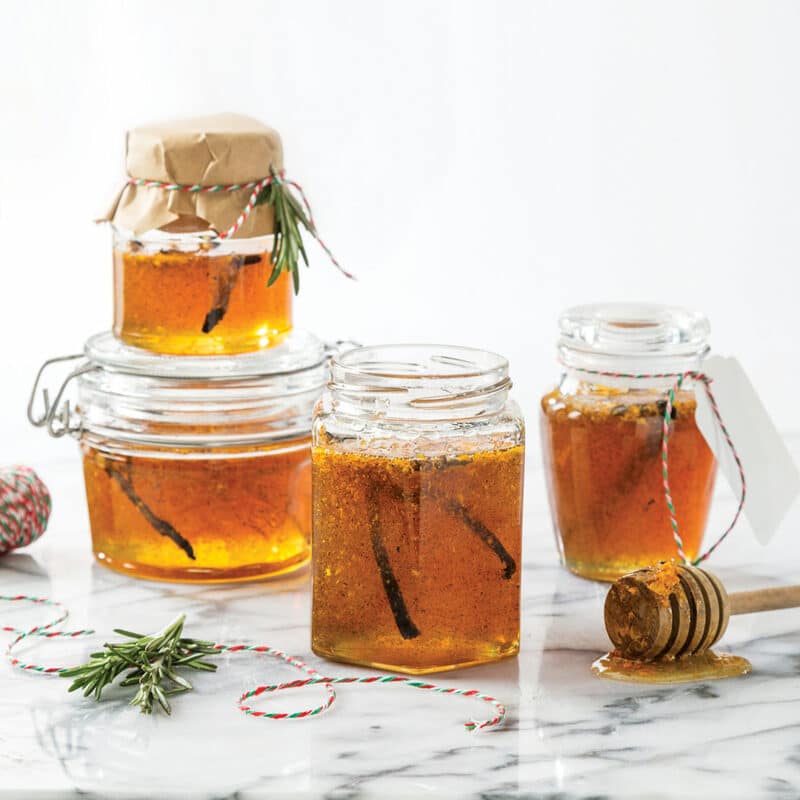
Raw honey and infused honey are products that initially come from honey bees, but the two are actually quite different. Raw honey is the golden substance that is produced in its most natural form and is harvested straight from a honey bee hive. This honey is not pasteurized, so it contains antimicrobial properties and is considered a live product because of the bacteria found inside it.
Infused honey is a method of creating a different flavor of honey by mixing it with various herbs or spices. While it begins with raw honey, once additional herbs are infused with this product, the taste and color of that initial honey can completely change!
Popular Infused Honey Flavors and Recipes
Infusing honey is a fun activity that anyone can do to enhance the flavor of the honey that they have at home. In general, infused honey can be made by adding various herbs or spices to a jar of raw honey, and letting the jar sit covered and undisturbed for one to two weeks. Here are a few popular infused honey flavors and their recipes.
Hot Honey:
Give your honey a little kick before you drizzle it over your next meal by infusing it with fresh habanero peppers and spicy dried red peppers. View the recipe by Chili Pepper Madness here.
Ginger Honey:
Fight the flu by adding ginger to your honey, which contains anti-inflammatory and antiviral properties. For this recipe, all you’ll need is raw honey and grated ginger.
Cinnamon Honey:
Cinnamon contains many antioxidants, so infusing your honey with this spice is a great way to prepare for the colder months ahead. Just combine raw honey, cinnamon sticks, and a pinch of ground cinnamon in a saucepan on low heat. (Be careful not to heat the honey too much). Here’s the full recipe.
Vanilla Honey:
Drizzle this sweet honey over yogurt, ice cream, or serve it with your next charcuterie board! All you’ll need for this recipe is raw honey and one split vanilla bean.
Fermented Honey Cranberries:
This is a recommended recipe from Mariah, and it involves fermentation. Cranberries is a go-to side dish for the holidays, and fermenting them with honey can help aid digestion. This recipe only requires five ingredients and can be turned into a cranberry sauce or just eaten on its own.
Ways to Serve Honey
Raw honey can take on so many wonderful flavors but did you know that it can be served in different ways, too? Here are a few ways to enjoy this sweet substance that go beyond the classic drizzle.
- Creamed honey: Also known as “spreadable honey”, this honey comes from the mixture of crystallized honey with smooth honey, and is Che’s favorite way to eat honey. When this honey has very small sugar crystals, it begins to slightly crystallize, but you’re still able to take a knife and spread it on toast or add it to a charcuterie board.
- Crystalized honey: If you’ve noticed that your honey takes on a pale gold, solid appearance…well then you hit the jackpot! This is the process of crystallization and gives you that amazing crunchy texture. You can heat this crystallized honey back down to its liquid form, or place the crystals into a blender and create your own powder that can be used in baking recipes.
- Honey Butter: Elevate your morning toast or dinner roll by spreading sweet honey butter on it! This is an easy way to incorporate the sweetness of honey and savoriness of butter – and can be made in just five minutes.
- Frozen Honey: Over the last year, “frozen honey” became a viral topic on TikTok – and for good reason! TikTok users discovered that by putting their raw honey inside of a squeezable bottle and placing it in the freezer…it took on a whole new form. The result? A sticky sweet and thick viscous texture that makes for a fun snack.
FAQs
Q: How many different types of honey are there?
A: Since honey is produced from the nectar of flowers that honey bees pollinate, there’s truly no telling just how many varieties of raw honey there can be!
Q: What is raw honey?
A: When honey is labeled as “raw”, this means that the honey inside that jar came directly from the honeycomb found in the beehive, without any processing such as fine filtering or heating.
Q: What does the color of my honey mean?
A: The color of any raw honey is directly related to the time of year, as well as the plants that honey bees have pollinated. For example, clover honey has a light amber color, while buckwheat honey has a very dark color (and bold flavor).


